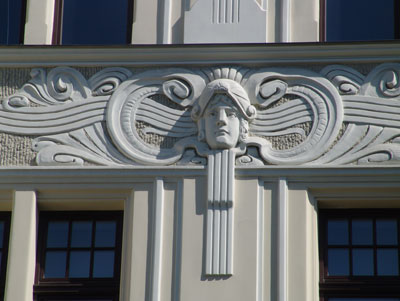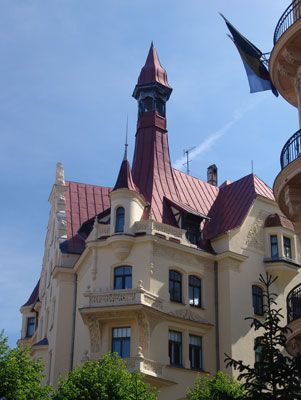Art Nouveau in Riga
When my wife, Kathryn, and I visited the ancient port city of Riga, Latvia, in July ’08, we were particularly interested in its Art Nouveau architecture, the best in Europe.
We stayed at the 4-star Hotel Avalon (70 Kaleju St., Riga; phone +371 671 69999, fax 671 60571, www.hotelavalon.eu). Its bright, airy courtyard atrium takes your breath away. A fine buffet breakfast comes with the room ($130 per night, double), a restaurant and bar are available, and the sixth-floor terrace overlooks Old Town.
Ornamentation is the hallmark of Art Nouveau, or Jugendstil, which began in Germany and spread throughout Europe a century ago. Stylized birds, plants, animals, shells and elaborate flower motifs are typical. Philosophically, Art Nouveau introduced the concept that everything should be beautiful.
The architecture survived in Riga more than in many German cities that were bombed during World War II. About one-third of all buildings in central Riga today were built in this style between 1896 and 1913. Riga’s historic city center, with its combination of neoclassical and Art Nouveau architecture, has earned a place among UNESCO’s World Heritage Sites.
Rows of marvelous Art Nouveau buildings, some restored, others still suffering from neglect during the Soviet era, stand proudly along Alberta Iela (street), where the most extravagant and stunning examples of the style are located.
This cobbled street is lined by 5-story buildings constructed at the height of the period, at a time when Latvia was part of the Soviet empire. Various substyles developed, such as Perpendicular Art Nouveau. After 1905, distinctive Latvian National Romanticism added traditional Latvian motifs and was less flamboyant.
Five of the most decorated apartment buildings along Alberta Street are the work of Mikhail Eisenstein, father of the Russian film director Sergei Eisenstein. With lions astride the turrets, 12 Alberta Street was Eisenstein’s home for several years. One balcony sports a lion and a goddess and is rich with floral motifs.
The entrance to another building, the childhood home of philosopher Isaiah Berlin from 1909 to 1915, is flanked by two sphinxes. Farther on, an Indian figure screams from a balustrade, feminine faces smile and frown and a bearded ancient god looks down on an elaborate iron gate. Sculpted cats, gargoyles… . It’s enough to make any fan of architecture drool.
Many consider the beautifully renovated 1905 facade of the Stockholm School of Economics to be the city’s most stunning example of Art Nouveau architecture.
The streets to explore are Ausekla, Vilandes, Rupniecibas, Pulkveza, Strelnieku, Elizabetes, Antonijas and, of course, Alberta.
Although most Art Nouveau buildings are in the New Town, some are located in the Old Town, among them the cake shop, a bank and apartments.
Riga is a wonderful mix of architecture, ranging from medieval, neoclassical and baroque to neo-Gothic and, yes, grim Soviet-era apartment buildings.
We purchased a Riga Card, which yielded a wide range of discounts at selected restaurants, cafés, theaters and museums and included a free city walking tour, free admission to many museums, a free copy of the “Riga in Your Pocket” guide and more. There are one-, 2- and 3-day cards for $16, $24 and $32. The card can be bought in the city at tourist centers or online at www.riga card.lv.
Pork and potatoes still reign in Riga, but recent years have brought a great variety to the restaurant scene, from Arabian cuisine to Central Asian. Our best dinner was at Restaurant Bel Ami at the Nordic Hotel Bellevue (33 Raina Blvd., Riga LV 1050, Latvia; phone +371 6706 3400, www.nordichotels.eu), with entrées about $26-$33.
For more information, visit www.rigatourism.com or www.lativatourism.lv. For information on a city bus tour, visit www.sightseeing.lv.
HARVEY HAGMAN
Fort Myers, FL



